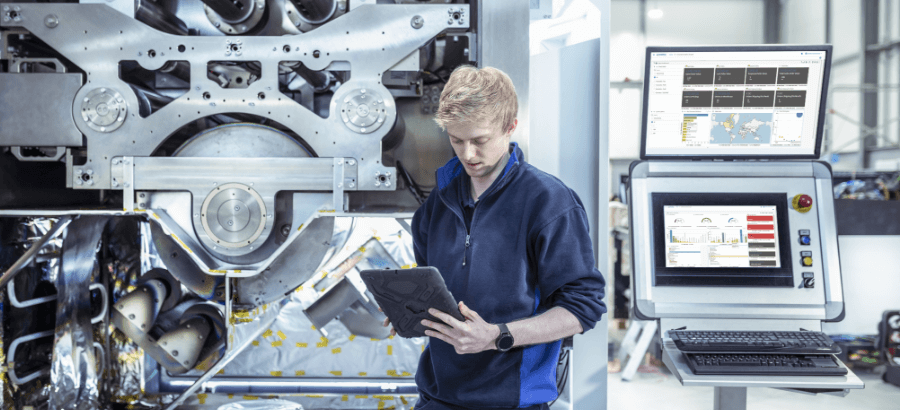The manufacturing industry confronted many uncertainties in the last year due to the pandemic. The supply chain was shaken by disruptions and market volatility, and the need for adaptation became immediate. 2020 SYSPRO research showed that 60% of businesses were impacted by supply chain disruptions during the pandemic. Businesses were unable to operate at the same level of efficiency as they were facing operational inefficiencies and the increased need for remote collaboration.
The pandemic has led to many shifts in manufacturing including new challenges to overcome. Old systems are being challenged by new players, and legacy companies are reinventing themselves to better address the needs of their customers. Industries are facing the need to plan new strategies and invest more in technology to gain a stronger foothold.
Here is a list of challenges and solutions for manufacturers to remain resilient and maintain growth momentum.
1. Transitioning to B2B e-Commerce
We live in a time where we can purchase almost anything with a click of a button. E-commerce platforms are now ubiquitous in the B2C space. The ease in which they provide in managing services or products is leading those in the B2B space to consider the missed opportunity. A B2B e-commerce strategy is therefore becoming increasingly necessary for manufacturing businesses that want to better sell their products or procure the necessary components for manufacturing them. By establishing a B2B e-commerce system, manufacturing companies provide greater flexibility, better inventory management, and decrease the likelihood of human error. In fact, SYSPRO research showed that 67% of businesses who had the ability to initiate digital strategies such as e-commerce, digital supply chains and remote working could continue to trade effectively during the pandemic.
With the rise of digital transformation manufacturers can use ERP to implement their e-commerce strategies. With one universal touchpoint, businesses can have full visibility of inventory levels along with backend systems to handle procurement and sourcing policy changes, distribution, and lead time planning as well as analytics providing data real-time to support improved decision-making.
2. Maintaining competitive advantage
Manufacturing has remained incredibly analog as far as service goes, and the pandemic revealed that it was not as agile as it should have been. With a reliance on manual processes and legacy systems, manufacturers simply could not respond quickly enough to industry disruptions and customer requirements. In a SYSPRO-led research study 37% of businesses agreed that their business systems lacked those basic planning tools that could adjust to day-to-day changes in the environment.
During the pandemic smaller, niche players that could address direct customer needs because of their ability to tap into emerging technologies and the right capabilities to compete in the marketplace maintained competitive advantage. Manufacturers now need to understand the market more than ever and replace systems to improve visibility of critical data, increase productivity, reduce waste, lower production costs, enable greater quality control and improve the management of schedules and production rates. Having accurate and real-time visibility into inventory levels will provide additional advantage. An ERP system can support this by allowing businesses to analyze forecasted demand, accurately predict production targets and meet demand levels.
3. Leveraging on predictive analytics and data for decision making
The manufacturing industry was not prepared for the pandemic. From our research, 29% of businesses felt that their business systems did not provide them with the availability and accessibility to manage the changes that the pandemic introduced and to predict future developments.
With the increasing use of the Internet of Things (IoT), the manufacturing industry is facing difficulties in aggregating and analyzing data. While many organizations may have smart machines already on their shop floor, they lack the systems to extract and analyze the data being captured by these systems. This forces manufacturers to miss out on quality. Therefore, manufacturers are facing the dire need to improve their data mining capacities to improve real-time decisions. In fact, 46% of businesses in our 2020 study felt that their systems lacked the insights that were needed to respond to the change. Instead, they relied on disparate systems and required manual interventions.
Adopting ERP systems makes it easier to leverage the deluge of data that’s coming in from connected sensors in their factories, inventories, and raw materials, and from signals along the supply chain. By extracting actionable intelligence from new and existing data sources to predict future trends and behaviors, manufacturers can make smarter business decisions when it comes to machine maintenance, supply chain optimization, the quality of goods produced, and when consumers receive orders. Rather than going off a ‘gut feeling’ manufacturers can leverage KPI’s to make informative decisions.
Manufacturers need to move away from legacy technology and processes and tap into the benefits of new solutions to tackle challenges in the digital era and to remain resilient in a post-pandemic world. Digital transformation offers an opportunity to make informed decisions, respond to challenges in real time and take advantage of market opportunities.








1 thought on “Top 3 challenges facing manufacturers and how to overcome them”